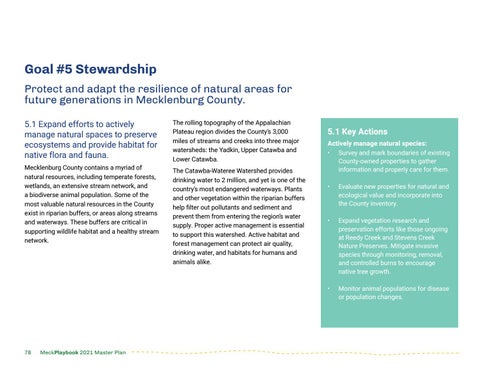Goal #5 Stewardship Protect and adapt the resilience of natural areas for future generations in Mecklenburg County. 5.1 Expand efforts to actively manage natural spaces to preserve ecosystems and provide habitat for native flora and fauna. Mecklenburg County contains a myriad of natural resources, including temperate forests, wetlands, an extensive stream network, and a biodiverse animal population. Some of the most valuable natural resources in the County exist in riparian buffers, or areas along streams and waterways. These buffers are critical in supporting wildlife habitat and a healthy stream network.
78
MeckPlaybook 2021 Master Plan
The rolling topography of the Appalachian Plateau region divides the County’s 3,000 miles of streams and creeks into three major watersheds: the Yadkin, Upper Catawba and Lower Catawba. The Catawba-Wateree Watershed provides drinking water to 2 million, and yet is one of the country’s most endangered waterways. Plants and other vegetation within the riparian buffers help filter out pollutants and sediment and prevent them from entering the region’s water supply. Proper active management is essential to support this watershed. Active habitat and forest management can protect air quality, drinking water, and habitats for humans and animals alike.
5.1 Key Actions Actively manage natural species: • Survey and mark boundaries of existing County-owned properties to gather information and properly care for them. •
Evaluate new properties for natural and ecological value and incorporate into the County inventory.
•
Expand vegetation research and preservation efforts like those ongoing at Reedy Creek and Stevens Creek Nature Preserves. Mitigate invasive species through monitoring, removal, and controlled burns to encourage native tree growth.
•
Monitor animal populations for disease or population changes.



















